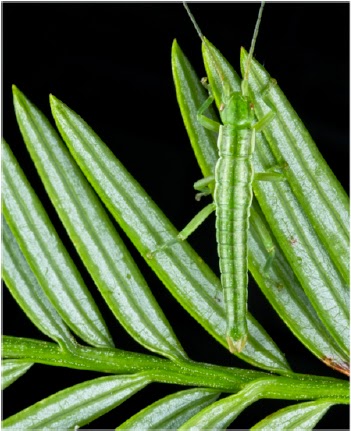Leaf Insects, Phylliidae, are small Insects related to Stick
Insects, noted for their remarkable camouflage patterns, which resemble leaves.
There are 53 described living species, 40 of which are placed in a single
genus, Phyllium, and one known
fossil, Eophyllium messelensis, from
the 47 million year old Messel Shale in Germany, which appears most of the
morphological characteristics seen in modern members of the group, suggesting
strongly that it already lived a similar lifestyle.
In a paper published in the journal Zootaxa on 2 October 2014,
Thomas van de Kamp of the Institute for Photon Science and SynchrotronRadiation at the Karlsruhe Institute of Technology and the State Museum ofNatural History Karlsruhe and Frank Hennemann of Freinsheim in Germany,
describe a new species of Leaf Insect from the mountains of Indonesian Papua.
The new species is named Phyllium riedeli,
in honour of the entomologist and Weevil specialist Alexander Riedel. The
species is named from a single female specimen collected in a Nothofagus (Southern Beech) forest over
2000 m above sea level. It is the smallest known member of the genus Phyllium, at 56.3 mm, and has a broad
abdomen, tapering to a point. It is pale green in colour, with red markings.
Female specimen of Phyllium riedeli
in (A) dorsal and (B) ventral views. Van de Kamp & Hennemann (2014).
The female laid four eggs after being captured. These were light
brown in colour, slightly glossy and 5.6-5.9 mm in length. It was not possible
to incubate any of the eggs.
Egg of Phyllium riedeli.(A)
Lateral aspect; (B) dorsal aspect; (C) ventral aspect.c = opercular crown; da=
dorsal appendage; mc = micropylar cup; mp = micropylar plate; op = operculum;
pa = polar appendage; vml = ventromedian lamella. Van de Kamp & Hennemann
(2014).
See also…
Stick Insects, Phasmida, are large insects noted for their camouflage
abilities, frequently resembling sticks or leaves. They are related to
Mantises, Cockroaches and Termites, and like them undergo hemimetabolous
development; the larval forms resemble the...
 The BMC Ecology Image Competition.
Scientific journals are the mainstay of academic communication within
the sciences, the place where new ideas are put forward in papers for
which the authors, rather than the editors, take responsibility. They
are not, on the whole, noted for either competitions or artistic
content. All such rules have exceptions however, and this year the
editors of the journal BMC Ecology decided to hold an Ecology Image Competition, which would be open only
to scientists working...
The BMC Ecology Image Competition.
Scientific journals are the mainstay of academic communication within
the sciences, the place where new ideas are put forward in papers for
which the authors, rather than the editors, take responsibility. They
are not, on the whole, noted for either competitions or artistic
content. All such rules have exceptions however, and this year the
editors of the journal BMC Ecology decided to hold an Ecology Image Competition, which would be open only
to scientists working...
 The BMC Ecology Image Competition.
Scientific journals are the mainstay of academic communication within
the sciences, the place where new ideas are put forward in papers for
which the authors, rather than the editors, take responsibility. They
are not, on the whole, noted for either competitions or artistic
content. All such rules have exceptions however, and this year the
editors of the journal BMC Ecology decided to hold an Ecology Image Competition, which would be open only
to scientists working...
The BMC Ecology Image Competition.
Scientific journals are the mainstay of academic communication within
the sciences, the place where new ideas are put forward in papers for
which the authors, rather than the editors, take responsibility. They
are not, on the whole, noted for either competitions or artistic
content. All such rules have exceptions however, and this year the
editors of the journal BMC Ecology decided to hold an Ecology Image Competition, which would be open only
to scientists working...
Follow Sciency Thoughts on Facebook.



